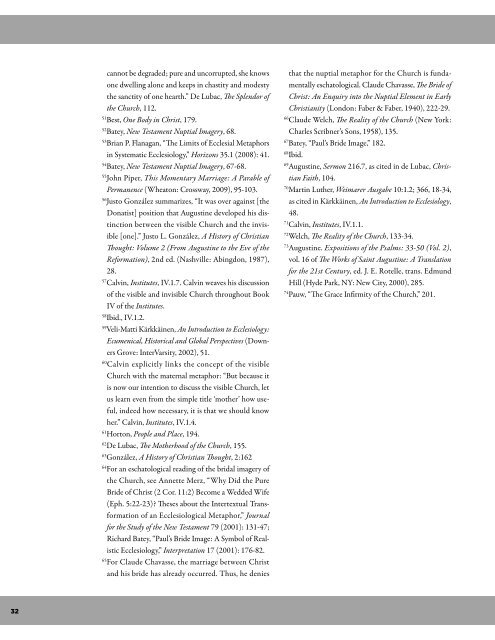here - The Southern Baptist Theological Seminary
here - The Southern Baptist Theological Seminary
here - The Southern Baptist Theological Seminary
You also want an ePaper? Increase the reach of your titles
YUMPU automatically turns print PDFs into web optimized ePapers that Google loves.
cannot be degraded; pure and uncorrupted, she knows<br />
one dwelling alone and keeps in chastity and modesty<br />
the sanctity of one hearth.” De Lubac, <strong>The</strong> Splendor of<br />
the Church, 112.<br />
51<br />
Best, One Body in Christ, 179.<br />
52<br />
Batey, New Testament Nuptial Imagery, 68.<br />
53<br />
Brian P. Flanagan, “<strong>The</strong> Limits of Ecclesial Metaphors<br />
in Systematic Ecclesiology,” Horizons 35.1 (2008): 41.<br />
54<br />
Batey, New Testament Nuptial Imagery, 67-68.<br />
55<br />
John Piper, This Momentary Marriage: A Parable of<br />
Permanence (Wheaton: Crossway, 2009), 95-103.<br />
56<br />
Justo González summarizes, “It was over against [the<br />
Donatist] position that Augustine developed his distinction<br />
between the visible Church and the invisible<br />
[one].” Justo L. González, A History of Christian<br />
Thought: Volume 2 (From Augustine to the Eve of the<br />
Reformation), 2nd ed. (Nashville: Abingdon, 1987),<br />
28.<br />
57<br />
Calvin, Institutes, IV.1.7. Calvin weaves his discussion<br />
of the visible and invisible Church throughout Book<br />
IV of the Institutes.<br />
58<br />
Ibid., IV.1.2.<br />
59<br />
Veli-Matti Kärkkäinen, An Introduction to Ecclesiology:<br />
Ecumenical, Historical and Global Perspectives (Downers<br />
Grove: InterVarsity, 2002), 51.<br />
60<br />
Calvin explicitly links the concept of the visible<br />
Church with the maternal metaphor: “But because it<br />
is now our intention to discuss the visible Church, let<br />
us learn even from the simple title ‘mother’ how useful,<br />
indeed how necessary, it is that we should know<br />
her.” Calvin, Institutes, IV.1.4.<br />
61<br />
Horton, People and Place, 194.<br />
that the nuptial metaphor for the Church is fundamentally<br />
eschatological. Claude Chavasse, <strong>The</strong> Bride of<br />
Christ: An Enquiry into the Nuptial Element in Early<br />
Christianity (London: Faber & Faber, 1940), 222-29.<br />
66<br />
Claude Welch, <strong>The</strong> Reality of the Church (New York:<br />
Charles Scribner’s Sons, 1958), 135.<br />
67<br />
Batey, “Paul’s Bride Image,” 182.<br />
68<br />
Ibid.<br />
69<br />
Augustine, Sermon 216.7, as cited in de Lubac, Christian<br />
Faith, 104.<br />
70<br />
Martin Luther, Weimarer Ausgabe 10:1.2; 366, 18-34,<br />
as cited in Kärkkäinen, An Introduction to Ecclesiology,<br />
48.<br />
71<br />
Calvin, Institutes, IV.1.1.<br />
72<br />
Welch, <strong>The</strong> Reality of the Church, 133-34.<br />
73<br />
Augustine. Expositions of the Psalms: 33-50 (Vol. 2),<br />
vol. 16 of <strong>The</strong> Works of Saint Augustine: A Translation<br />
for the 21st Century, ed. J. E. Rotelle, trans. Edmund<br />
Hill (Hyde Park, NY: New City, 2000), 285.<br />
74<br />
Pauw, “<strong>The</strong> Grace Infirmity of the Church,” 201.<br />
62<br />
De Lubac, <strong>The</strong> Motherhood of the Church, 155.<br />
63<br />
González, A History of Christian Thought, 2:162<br />
64<br />
For an eschatological reading of the bridal imagery of<br />
the Church, see Annette Merz, “Why Did the Pure<br />
Bride of Christ (2 Cor. 11:2) Become a Wedded Wife<br />
(Eph. 5:22-23)? <strong>The</strong>ses about the Intertextual Transformation<br />
of an Ecclesiological Metaphor,” Journal<br />
for the Study of the New Testament 79 (2001): 131-47;<br />
Richard Batey, “Paul’s Bride Image: A Symbol of Realistic<br />
Ecclesiology,” Interpretation 17 (2001): 176-82.<br />
65<br />
For Claude Chavasse, the marriage between Christ<br />
and his bride has already occurred. Thus, he denies<br />
32
















